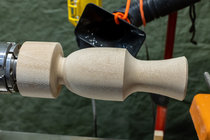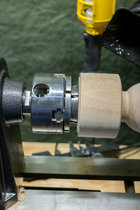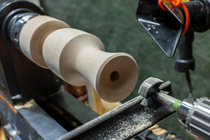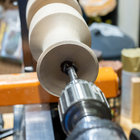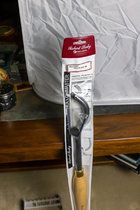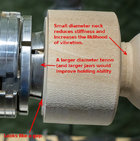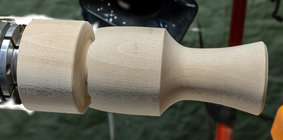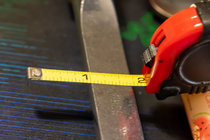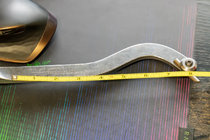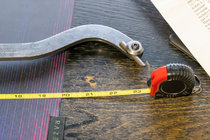With seeing the pics, it's as I surmised previously - you cut the bottom of the vase down way too far. Also the 2-3" below the vase bottom hurts the situation by increasing the distance the mass is from the chuck/support. You could save it as is with a steady rest, but it doesn't sound like you have one. While a larger tenon would help, I suspect the 50mm jaws are ok, provided the OD is not necked down toward the bottom until the upper 1/2 or more had been completely turned - ID and OD. I don't think the wood type is the issue.
Best opportunity to make something from this is to part off the entire bottom end below the vase bottom, turn a new tenon into the existing bottom, and go from there. Do not turn the bottom OD down any until you have hollowed at least 1/2 the depth.
For HF's, I prefer to use a forstner the dia of the hollowing hole to 1-2" depth, then use an auger bit the same size to go to ~1/4" of desired total depth. I then hollow out with various tools. I do think you are being pretty ambitious to hollow 12" depth or so with the tools listed. You need at least a 3/4" dia bar to get that deep, with a 3/16" to 1/4" size cutter, and a 3-4 ft long handle. You may want to look at captive/articulating hollowing systems vs beefing up for hand held hollowing, I suggest this from experience. Doing more than 5-6" deep hand held is not fun. It requires constant concentration, one "ah sh*t" will blow up hours of work. My preference is Lyle Jamieson's system but there are other capable systems available.
Doug, thank you for your careful analysis.
I suspected turning down the base like that was part of the problem. I wasn't thinking, and kept working on it, then it hit me that I hadn't started the inside. I wondered if that would be contributing to the vibrations...sounds like it is.
Regarding depth of this particular vase, the entire blank was 12" (or maybe 11"...) The vase itself, which starts above that chunk that the tenon is turned into, above that part at the bottom that I turned too narrow, is 7 1/2" by my measurement. So I would probably be hollowing a little over 7" deep. That may be the deepest I've gone, not sure, I've turned some other vases about the same size (although out of slightly shorter blanks, so I didn't end up with a waste block on the tenon end like I did in this case.) I do remember the EWT hollowers getting a bit grabby near the bottom of the prior vases...but, if there is anything this hobby teaches you, its patience.
FWIW, the hollow master is 1/4" cutter, and the bar is 3/4" wide with a flat bottom so it won't twist when cutting. I haven't used it yet, just bought it, but I picked that one up because it seemed large enough to handle a vase this size and a bit larger. I am not not sure if it will actually fit a small vase with a small neck like this... I do have some ~6x6x12" vase blanks to turn, and one is actually 5x5x16", and I think I have another that is a bit longer than 12". The latter I will need bigger tools, for sure. For the 12" blanks, with a bigger chuck, I figured there would be a 1" or so loss just to truing the top and bottom and cutting the tenon, and maybe a bit more once I've fully shaped the neck. Then depending on the thickness of the walls, I think the Hollow Master will do the job, although I may have to leave the base a little thick. I guess it may not be optimal...but I'm still a beginner and this stuff is mostly just learning ATM.

I do have some longer blanks, and I will probably need a better cutting system for hollowing those. I checked out the Lyle Jamieson system...very intriguing! The laser system sounds...well, kind of sounds essential. I've never quite been able to get calipers to give me a useful reading, and a lot of the time with these smaller vases I haven't been able to get the ones I have to even fit through the neck properly. A laser system would be so useful. He also has a DVD that covers hollowing techniques, and I may just get that to start. I've been sitting on these bigger blank for months and months now, as I haven't had the nerve to try and turn any of them yet. The Sorby Hollow Master was my first foray into a tool big enough that I thought I could actually turn one of them. I think I'll give it a try on the smallest blank, just to see if I can start developing some proper hollowing technique with that style of cutter. The EWT hollowers are fine for more small bowl-sized hollow forms or small vases like the one here (that I've totally botched!!), but they do get a bit grabby 5-6" or so in.

